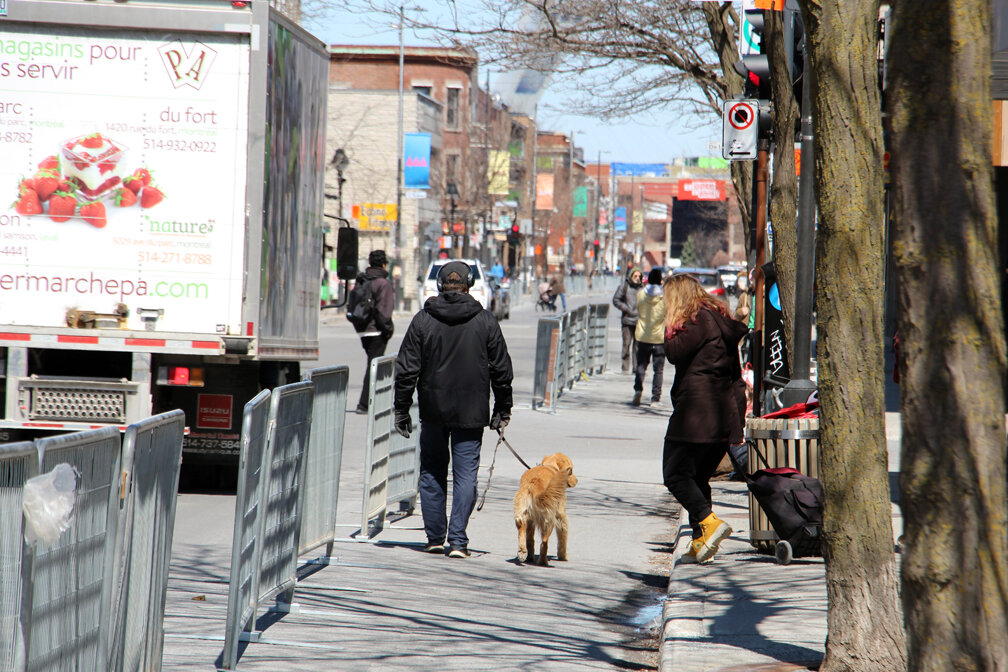Make Way for Pedestrians
Avenue Mont-Royal, Montréal (April 15 - April 20, 2020), PHOTOS CHRISTINE KERRIGAN
It's ironic that I was writing a poem inspired by how fences, borders and barriers can both protect and divide us, just as the metal fences were simultaneously being lined up to create the health corridor ("Corridor sanitaire") on Mont-Royal Avenue in my Plateau neighbourhood. Funny enough, this is one barrier that I am more than happy to get behind! *
The "Corridor sanitaire" is a pilot project in Montréal, which is being installed during the COVID-19 pandemic in the district of Plateau-Mont-Royal. Parking on one side of the street has been removed to offer pedestrians more space to protect their invisible 2-meter social distance bubble. Since I grew up in the US on a diet of inches, feet and yards, I am admittedly still adjusting to metric. I like to think about this space in a way that transcends international borders: it's roughly three times the distance of what I like to call the "garlic no fly zone" (or 3G). Given that the Plateau neighbourhood is the most densely populated district on the island of Montréal (and my fellow residents do love their garlic), it's the perfect spot for this pilot project to take shape.
The new corridor will run 2.7 KM long and be roughly 4.5 meters wide, including the sidewalk and the roadway.
In a non-pandemic environment, a trip down Mont-Royal Avenue would lead you strolling past a buffet of commercial and residential activity: mom and pop shops (Copain d'Abord bakery, we love you!), restaurants, new and used clothing boutiques, book stores, small and medium-size grocery stores, health food stores, pharmacies, dance studios, hair dressers... enfin bref, you get the idea. Most of these establishments are now closed with the exception of businesses that are considered "essential" such as grocery stores, pharmacies and the SAQ (liquor store). Hang on, the SAQ? I did initially do a double take when I discovered that the SAQ was drafted to the “E-team”. However, the SAQ is government-owned and wine, beer and spirits sales do tip the tax scales in a much-needed direction for the Québec government at this crucial moment in time. So, I'm feeling at peace with it. In fact, I feel empathy and gratitude to those people currently doing their best to manage this crisis on a municipal, provincial and federal level. This pandemic hit hard and fast, and there are so many moving parts and pieces. In fact, it's this motion and commotion that led me to wanting to write about mobility and health during the pandemic.
This week, I did some test runs (or walks, really) in the "Corridor sanitaire" to observe how and if pedestrians are using this extra space. Indeed they most definitely are. There are several sidewalks where it would be next to impossible to respect social distancing without walking in the street. This is especially the case in passing long lines in front of grocery stores, pharmacies and the SAQ. It also provides space for people who are self-isolating together to walk together, such as families with kids, couples, and people with dogs (or dogs with people).
Let's also not forget that making quick ducks, twists and turns to avoid on-coming pedestrians in narrowed spaces is not so easy when someone is in a wheelchair, using a walker or wheeling a baby carriage. Having extra space to keep a safe distance is not just a gift to zealous arm swingers, but rather a necessity in a time where being too close can lead to fatal consequences. It's also an important step in providing an active mobility option that is more inclusive and not just for those who can walk or run on two feet.
This is clearly not the first time that space has been taken away from cars and given back to pedestrians in the hopes of creating healthier urban environments. Over the few past decades, we've seen many projects sprout up around the globe where cities have carved out more space for pedestrians to run, walk, and wheel. Projects have ranged from new pedestrian
zones, temporary road closures to celebrate active transport, new space for protected bike lanes, and parking space make-overs (think about the event Parking Day, parklets in San Francisco and many other cities, the mostly car-free city centre in Ghent, Superblocks in Barcelona, etc.). However, we know that we are currently not living in typical times and it's surely easier to consider removing parking when car traffic is already significantly reduced and the vast majority of the commercial establishments on the street are closed.
Montréal's new "Corridor sanitaire" will not win design awards for its aesthetics, but that's OK, because it's gett'n the job done. In a time where response time had to be swift and budgets are tight, you can't always ask for a 2.7 KM vegetal wall built from gorgeous local plants and trees. Nevertheless, we should be exploring what data can be collected during this time, get citizen input, and reflect on what we can learn from this experience. No one wants to think about a possible repeat pandemic, but we need to be prepared none-the-less. Furthermore, the more we share the results of our pilots between different neighbourhoods and cities, the better off and healthier we will all be. I hope that other cities will also consider implementing health corridors to keep their citizens safe and help slow the spread of the COVID-19 virus. Therein lies my motivation for writing this article. Well, that and a healthy dose of neighbourhood and Montréal pride.
No matter how awesome Montréal is, I surely don’t forget my New England roots south of the border. The title of this article is a subtle shout-out to my family, friends and colleagues back in Boston who grew up on Robert McCloskey’s classic tale “Make Way for Ducklings.”
* You're think'n "No she didn't." But yes, she did.







